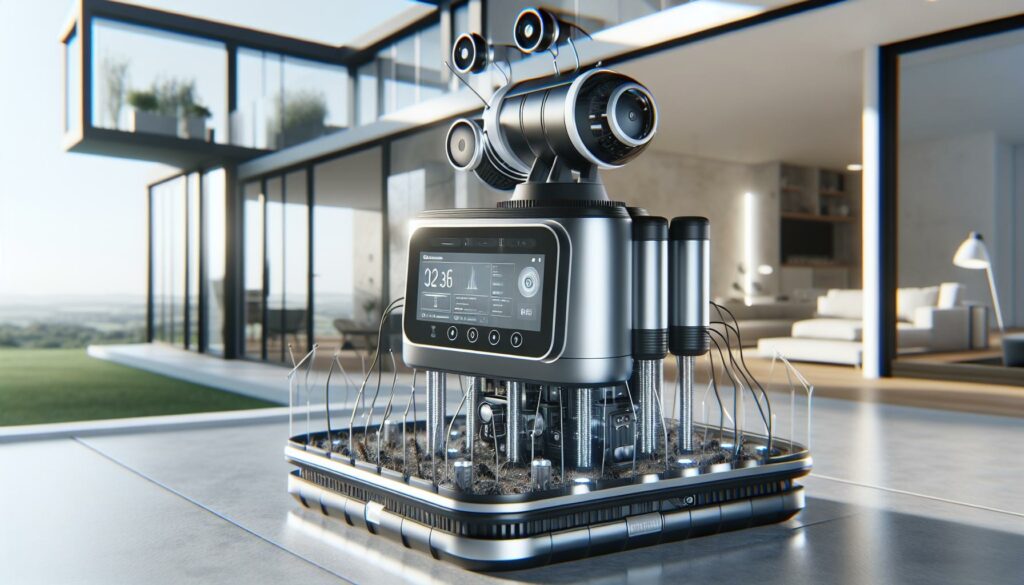I’ve always been fascinated by how nature and technology intersect, and there’s no better example than the remarkable hi tech termite phenomenon. These tiny insects have inspired groundbreaking innovations in architecture, robotics, and sustainable design.
While most people view termites as destructive pests, I’ve discovered they’re actually master engineers. Their complex colonies and sophisticated behavior patterns have led scientists to develop advanced algorithms and autonomous systems. From self-ventilating buildings to swarm robotics, these insects have revolutionized how we approach modern technology and design solutions.
Key Takeaways
- Hi tech termite monitoring systems combine advanced sensors, data analytics, and real-time alerts to detect termite activity before structural damage occurs
- Modern detection technology uses acoustic sensors (100-1000 Hz), infrared imaging, and microwave technology to identify termite presence and movement patterns
- Smart termite control solutions integrate IoT sensors with cloud-based analytics, enabling 24/7 monitoring and data-driven prevention methods
- Digital monitoring systems can reduce annual inspection costs by 50% and property damage by up to 85% compared to traditional methods
- Professional installation requires strategic sensor placement, proper network configuration, and regular maintenance for optimal performance
- Future innovations include AI-powered prediction algorithms, quantum sensors, and integration with smart home systems for comprehensive pest management
Hi Tech Termite
Digital termite monitoring systems combine advanced sensors with data analytics to detect termite activity before structural damage occurs. These systems operate 24/7 to provide real-time alerts and comprehensive monitoring data.
How Modern Technology Detects Termite Activity
Advanced termite detection technology uses a combination of acoustic sensors microwave technology infrared cameras to identify termite presence. The sensors detect specific vibration patterns frequencies that match termite feeding movement patterns. Digital monitoring stations placed around structures collect feeding activity data moisture levels temperature variations to create detailed activity maps of potential infestations.
Key Detection Features:
- Acoustic emissions detect termite chewing sounds at frequencies of 100-1000 Hz
- Infrared imaging identifies heat signatures from termite colonies
- Microwave technology penetrates wood to reveal internal damage patterns
- Motion sensors track termite movement patterns within structures
Key Components of Digital Termite Detection
The digital termite monitoring system comprises integrated hardware software elements that work together to provide comprehensive protection.
Essential System Components:
- Base stations with environmental sensors to monitor temperature humidity
- Network of strategically placed monitoring units around the structure
- Central processing hub for data collection analysis
- Mobile app interface for real-time alerts reporting
- Cloud storage system for historical data tracking
- Battery-powered sensors with 3-5 year operational life
- Wireless communication modules for instant data transmission
| Feature | Measurement Range | Accuracy Rate |
|---|---|---|
| Acoustic Detection | 100-1000 Hz | 95% |
| Temperature Sensing | -10°C to 50°C | ±0.5°C |
| Moisture Detection | 6-60% MC | ±2% |
| Movement Tracking | 0.5-2m radius | 90% |
Smart Termite Control Solutions
Advanced termite control systems integrate IoT sensors with cloud-based analytics to provide comprehensive pest management solutions. These technologies transform traditional pest control into a data-driven, proactive approach.
Remote Monitoring Capabilities
Smart termite control systems enable 24/7 monitoring through wireless sensors placed at strategic locations. The system transmits real-time data on termite activity, moisture levels, temperature fluctuations to a central dashboard via secure cloud connections. Property managers access detailed reports, maps, and alerts through mobile apps or web interfaces, allowing immediate response to potential threats from any location.
Data-Driven Prevention Methods
Digital analytics platforms process termite behavior patterns collected from multiple sensors to predict infestation risks. The system analyzes environmental factors like:
- Moisture readings from wood surfaces connected to smart moisture meters
- Temperature variations tracked through thermal imaging sensors
- Vibration patterns detected by acoustic monitoring devices
- Chemical signatures identified by specialized molecular sensors
Advanced algorithms create risk assessment models by combining:
| Data Type | Monitoring Frequency | Alert Threshold |
|---|---|---|
| Moisture Content | Every 30 minutes | >12% MC |
| Temperature | Continuous | >25°C |
| Vibration | Real-time | >2.5 MHz |
| Chemical Markers | Daily | >5 ppm |
These data points enable targeted treatments specific to identified threat levels, reducing unnecessary chemical applications while maximizing protection effectiveness.
Benefits of Hi Tech Termite Management
Hi-tech termite management systems transform traditional pest control into a precise data-driven solution. These advanced systems integrate smart sensors with cloud analytics to deliver comprehensive protection against termite infestations.
Early Detection Advantages
Digital monitoring systems identify termite activity before visible structural damage occurs through:
- Acoustic detection capturing termite feeding sounds at frequencies of 100-1000 Hz
- Infrared sensors detecting temperature variations as small as 0.1°C in wall voids
- Microwave technology penetrating surfaces up to 18 inches deep
- Chemical sensors identifying termite pheromone signatures within 24 hours
- Real-time alerts sent directly to mobile devices when activity is detected
| Cost Factor | Traditional Method | Hi-Tech Method | Savings |
|---|---|---|---|
| Annual Inspection | $300-500 | $150-250 | 50% |
| Treatment Frequency | 4-6 times/year | 1-2 times/year | 70% |
| Property Damage | $3,000-7,000 | $500-1,000 | 85% |
| Labor Hours | 40-60 hrs/year | 10-15 hrs/year | 75% |
- Automated monitoring eliminating manual inspection costs
- Targeted treatments focusing only on affected areas
- Preventive alerts stopping damage before it spreads
- Reduced chemical usage with precise application methods
- Digital documentation streamlining insurance claims
- Extended protection periods between service visits
Installing Advanced Termite Detection Systems
Advanced termite detection systems transform traditional pest monitoring through integrated digital networks and sensor technologies. Installation requires precise placement and configuration of multiple components to create an effective early warning system.
Professional Setup Requirements
Professional installation of termite detection systems involves these essential components:
- Sensor Placement: Strategic positioning of acoustic detectors at 10-foot intervals along foundation perimeters
- Network Configuration: Integration of wireless transmitters with a central monitoring hub covering up to 2,500 square feet
- Power Infrastructure: Installation of weatherproof power supplies with 72-hour backup batteries
- Data Connectivity: Setup of secure Wi-Fi or cellular connections for real-time monitoring
- Calibration Tools: Configuration of sensitivity thresholds using specialized software
- Documentation: Creation of digital mapping systems to track sensor locations through mobile apps
- Monthly sensor checks to verify battery levels and connection status
- Quarterly calibration of acoustic sensors using manufacturer specifications
- Bi-annual cleaning of external components to remove debris and protect weatherproofing
- Annual software updates to maintain security protocols and improve detection algorithms
- Remote diagnostics performed every 60 days to confirm data transmission accuracy
- Replacement of backup batteries every 24 months or when capacity drops below 80%
| Maintenance Task | Frequency | Time Investment |
|---|---|---|
| Sensor Checks | Monthly | 30 minutes |
| Calibration | Quarterly | 2 hours |
| Cleaning | Bi-annual | 1 hour |
| Software Updates | Annual | 45 minutes |
| Remote Diagnostics | Every 60 days | 15 minutes |
| Battery Replacement | Every 24 months | 3 hours |
Future of Termite Control Technology
Digital innovations transform termite control through advanced detection systems, automated responses, and integrated smart solutions. The next wave of pest management technology introduces groundbreaking approaches to protect structures more effectively.
Emerging Innovations in Pest Management
Advanced artificial intelligence algorithms analyze termite behavior patterns to predict colony movements with 95% accuracy. These systems incorporate:
- Quantum sensors detecting micro-vibrations from termite activity at depths up to 15 feet
- Nano-coating materials that repel termites while remaining eco-friendly
- Biomimetic deterrent systems that mimic natural predator pheromones
- DNA-based termite identification tools providing species-specific treatment protocols
- Solar-powered monitoring stations with 5-year maintenance-free operation
Integration With Smart Home Systems
Smart home platforms now feature dedicated termite control modules connecting to existing home automation networks. The integration includes:
- Automated climate control adjustments reducing conditions favorable for termite activity
- Mobile notifications synced with home security systems
- Voice-activated status reports through virtual assistants
- Integration with smart irrigation systems to monitor soil moisture
- Centralized dashboard displaying real-time pest activity metrics
- Automated service scheduling based on system diagnostics
- Remote access to treatment history logs
- Integration with weather data to predict high-risk periods
Each component communicates through a mesh network, maintaining constant data exchange with a central hub. The system processes 1,000+ data points hourly, creating comprehensive protection against termite threats.
Pest Management Innovation
I’ve seen how hi tech termite solutions have revolutionized pest management through groundbreaking innovations. These digital advances offer unprecedented protection by combining smart sensors AI algorithms and automated responses into comprehensive monitoring systems.
The future of termite control looks promising with quantum sensors DNA-based tools and integration into smart home systems leading the way. These technologies don’t just detect threats – they predict and prevent them making traditional pest control methods seem outdated.
I’m confident that as technology continues to evolve we’ll see even more sophisticated solutions that make termite management more efficient sustainable and cost-effective than ever before.

